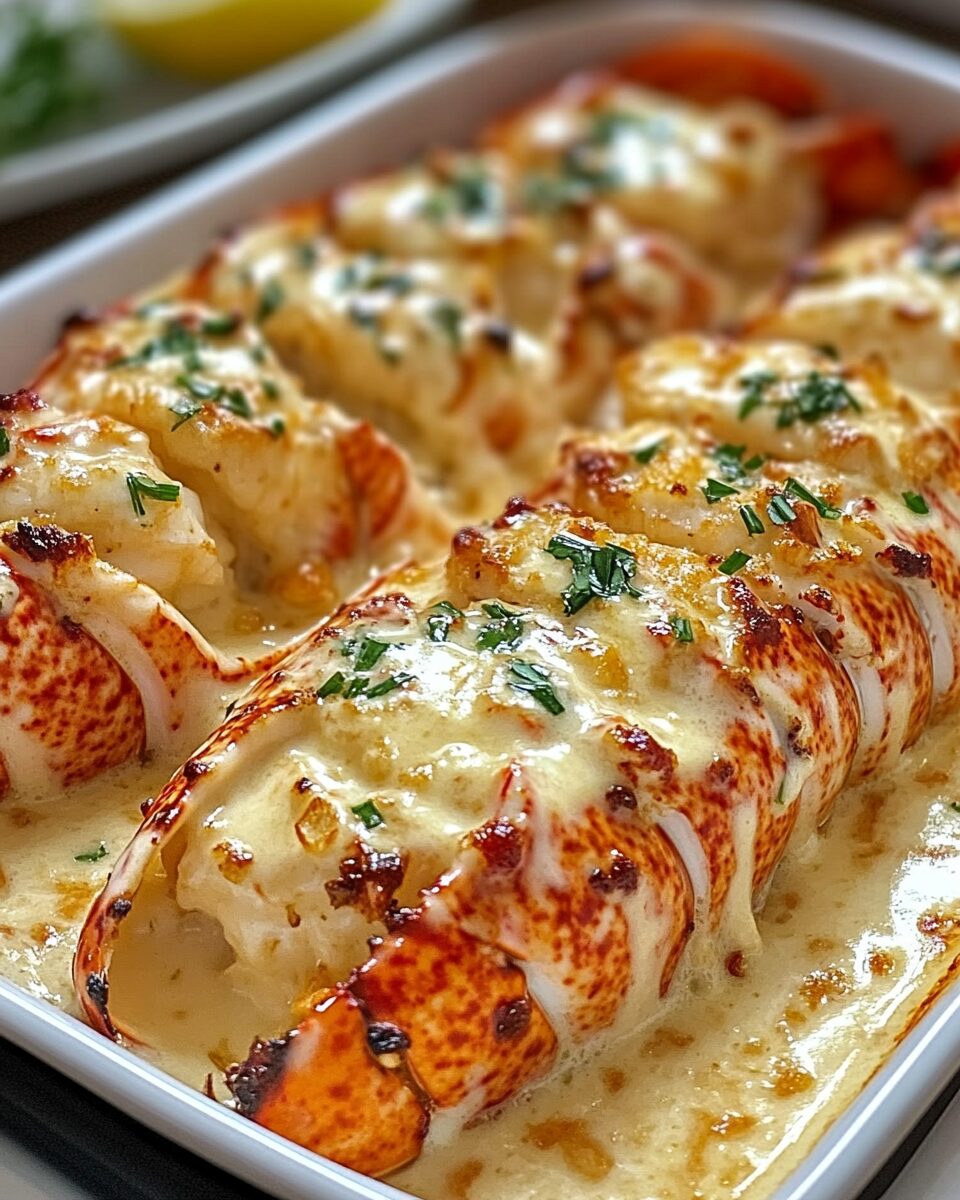Lobster Thermidor is a quintessential French dish that embodies sophistication and indulgence. Originating in Paris in the late 19th century, it has become a symbol of luxury dining. The combination of tender lobster meat enveloped in a rich, creamy mustard sauce, topped with melted cheese and a golden breadcrumb crust, offers a symphony of flavors and textures that delight the senses.
This dish is perfect for special occasions such as anniversaries, holidays, or intimate gatherings. Its elegant presentation and exquisite taste make it a standout centerpiece on any table. Whether you’re a seasoned chef or a home cook looking to impress, Lobster Thermidor is a recipe that promises to elevate your culinary repertoire and create memorable dining experiences.
Full Recipe
Ingredients:
-
2 whole lobsters (about 1½ lbs each)
-
2 tbsp unsalted butter
-
1 small onion, finely diced
-
¼ cup dry white wine
-
¼ cup lobster or fish stock
-
¼ cup heavy cream
-
1 tbsp Dijon mustard
-
1 tbsp fresh lemon juice
-
2 egg yolks, lightly beaten
-
¼ cup grated Gruyère or Parmesan cheese
-
1 tbsp fresh parsley, chopped (for garnish)
-
Salt and freshly ground black pepper, to taste
-
1 tbsp breadcrumbs (optional, for topping)
Directions:
-
Cook the Lobsters: Bring a large pot of salted water to a rolling boil. Carefully add the lobsters and cook for about 8–10 minutes, or until their shells turn a vibrant red hue. Once cooked, remove them from the pot and let them cool for a few minutes. Split the lobsters in half lengthwise, extracting the meat from the tail and claws, and chop into bite-sized pieces. Reserve the shells for presentation.
-
Prepare the Sauce: In a medium skillet, melt the butter over medium heat. Add the finely diced onion and sauté until softened, about 3 minutes. Pour in the dry white wine, allowing it to reduce by half for a richer flavor. Stir in the lobster stock and heavy cream, cooking for an additional 2–3 minutes until the sauce slightly thickens.
-
Finish the Thermidor Sauce: Stir in the Dijon mustard and squeeze in the fresh lemon juice. Remove the skillet from heat and gradually whisk in the lightly beaten egg yolks. Return the skillet to low heat, stirring constantly to gently thicken the sauce without bringing it to a boil. Season with salt and pepper to taste.
-
Assemble the Lobsters: Incorporate the chopped lobster meat into the cream sauce, mixing thoroughly. Spoon this luxurious mixture back into the reserved lobster shells, filling them generously. For added flavor and texture, sprinkle each with grated Gruyère or Parmesan cheese. Optionally, top with breadcrumbs for a crispy finish.
-
Broil the Lobsters: Preheat your broiler and place the stuffed lobster halves onto a baking sheet. Broil for 3–5 minutes, or until the cheese is beautifully melted and turns golden brown. This quick broiling step enhances the flavor and provides a delightful contrast to the creamy interior.
Prep Time: 15 minutes
Cooking Time: 35 minutes
Total Time: 50 minutes
Kcal: Approximately 450 kcal per serving
Servings: 4 servings
The Legacy of Lobster Thermidor
Lobster Thermidor is one of those rare recipes that blend historical significance, culinary sophistication, and sheer indulgence. Its roots trace back to late 19th-century Paris, where French chefs pushed the boundaries of classic cuisine. Named after the play Thermidor, which premiered in 1891, this dish quickly became associated with opulence and high society. It made its way into prestigious restaurants and gourmet kitchens around the world and continues to hold a place of honor in fine dining menus today.
This French delicacy, featuring succulent lobster meat bathed in a creamy, wine-infused mustard sauce and broiled with melted cheese, is as much about presentation as it is about flavor. The shells serve not only as a natural vessel but also as a dramatic centerpiece. From Parisian bistros to five-star hotels, Lobster Thermidor represents the pinnacle of classic European cuisine.
What Makes Lobster Thermidor So Special?
What sets Lobster Thermidor apart is its luxurious combination of ingredients. It’s a dish that elevates seafood to gourmet status through rich, nuanced flavors and intricate textures. The creamy sauce is typically a blend of egg yolks, cream, wine, and Dijon mustard—creating a velvety emulsion that coats each piece of lobster in decadent flavor. The topping of Gruyère or Parmesan adds an umami depth, and the slight crisp from the broiler adds a perfect contrast.
Beyond its indulgent profile, the Thermidor preparation method respects the delicacy of the lobster. It doesn’t overpower the natural sweetness of the meat but rather enhances it. When done correctly, every bite balances buttery richness, zesty brightness from lemon, and a hint of tang from the mustard. The visual appeal—creamy filling nestled inside bright red lobster shells, topped with golden cheese—makes it a show-stopping dish ideal for festive occasions.
Perfect for Celebrations and Special Dinners
Lobster Thermidor isn’t your everyday dinner recipe—it’s a celebration on a plate. Whether it’s a romantic dinner for two, a holiday feast, or a milestone birthday, this dish adds instant elegance to any table. Because it takes a bit more time and attention than simpler meals, it’s often reserved for events when making a lasting impression matters.
Its theatrical presentation and rich aroma when pulled fresh from the broiler instantly captivate guests. Pair it with a bottle of chilled Chardonnay or Champagne, a simple green salad, and perhaps a side of buttered asparagus or roasted potatoes, and you have a complete dining experience that feels straight out of a fine restaurant.
Cultural Relevance and Global Variations
Although Lobster Thermidor originated in France, it has taken on many regional interpretations over the decades. In the United States, for example, it’s sometimes made with a touch of brandy or cognac and may use cheddar instead of Gruyère. In Southeast Asia, fusion versions exist with chili or lemongrass added to suit local palates. In Italy, some chefs incorporate mascarpone or pecorino for a regional twist.
These global variations underscore the versatility of the Thermidor concept. At its core, it’s about taking the prized lobster and showcasing it in the most elegant way possible. Whether served at a French brasserie or a Caribbean resort, it holds a universal charm that transcends cultural borders.
Tips for the Best Lobster Thermidor
Achieving the perfect Lobster Thermidor requires care and attention to detail. First, always choose fresh, high-quality lobster. If you’re able to get live lobsters, you’ll be rewarded with better texture and flavor. When cooking the lobster, it’s crucial not to overboil, as it can make the meat rubbery.
Secondly, be gentle with the sauce. Whisking egg yolks into a hot mixture can curdle them if you’re not careful. Always temper the yolks by gradually adding warm liquid to them before stirring into the hot pan. Keep the heat low and stir continuously for a smooth, silky finish.
Cheese selection also matters. Gruyère offers a nutty richness without overpowering the lobster’s delicate sweetness. If using Parmesan, opt for freshly grated rather than pre-packaged to avoid a waxy texture. Breadcrumbs are optional, but they can add a nice crunch if you want more contrast in texture.
Health Considerations
While Lobster Thermidor is undeniably rich, it can be part of a balanced diet when enjoyed in moderation. Lobster itself is a lean source of protein and packed with nutrients like zinc, vitamin B12, and omega-3 fatty acids. The calorie-dense components—cream, butter, cheese—can be adjusted slightly for a lighter version. For instance, you can swap heavy cream for half-and-half or use Greek yogurt for part of the sauce base.
Still, this dish is more about indulgence than everyday health food. It’s a recipe designed to savor, not necessarily to slim down. And there’s nothing wrong with enjoying a little decadence once in a while, especially when the occasion calls for it.
Wine Pairing Suggestions
Because of its creamy, buttery texture and slightly tangy sauce, Lobster Thermidor pairs beautifully with white wines that offer good acidity and structure. Chardonnay, particularly those aged in oak, complements the dish’s richness with flavors of apple, vanilla, and toasted nuts. Sauvignon Blanc or a crisp Pinot Grigio can also bring a refreshing contrast that cuts through the cream.
If you’re in the mood for bubbles, Champagne or a good quality sparkling wine elevates the dish even further, making the meal feel festive and special. Whatever your choice, serving wine at the right temperature—cool but not overly chilled—ensures it enhances every bite.
How to Serve Lobster Thermidor
Serving Lobster Thermidor is as much about the visual impact as it is about flavor. Traditionally, the meat is removed from the shells, combined with the sauce, then returned and baked in the shell itself. This not only maintains the drama of presentation but also ensures the shell infuses a slight ocean essence into the filling.
It’s usually served with a minimal but elegant selection of sides—think grilled vegetables, wild rice pilaf, or even crusty artisan bread to mop up the sauce. A sprig of parsley or a wedge of lemon adds a final pop of color. For a truly memorable meal, serve the dish on elegant dinnerware, perhaps with candlelight or soft music to complete the fine-dining atmosphere at home.
The Art of Mastering a Classic
While the term “Thermidor” may sound intimidating, the actual process is very manageable for a home cook with some patience and attention to detail. The key lies in balancing richness with brightness, heat with subtlety, and decadence with finesse.
As with any timeless recipe, repetition is the key to perfection. The first attempt might be a learning experience, but each iteration brings you closer to mastering a dish that’s been beloved for over a century. Once you get the hang of it, you may find yourself revisiting it every time a special celebration rolls around.
Conclusion
Lobster Thermidor is more than just a dish—it’s an experience steeped in tradition, flavor, and culinary artistry. It invites diners to slow down, savor each bite, and appreciate the elegance of well-crafted food. Whether you’re recreating it to impress guests or indulging in a gourmet night at home, it’s a recipe that pays homage to fine dining’s golden era while remaining timelessly relevant.
Perfect for special occasions and memorable meals, Lobster Thermidor brings restaurant-level sophistication into your kitchen. With its rich history, luxurious ingredients, and unforgettable flavor, it’s a dish that doesn’t just feed the body—it feeds the soul.






